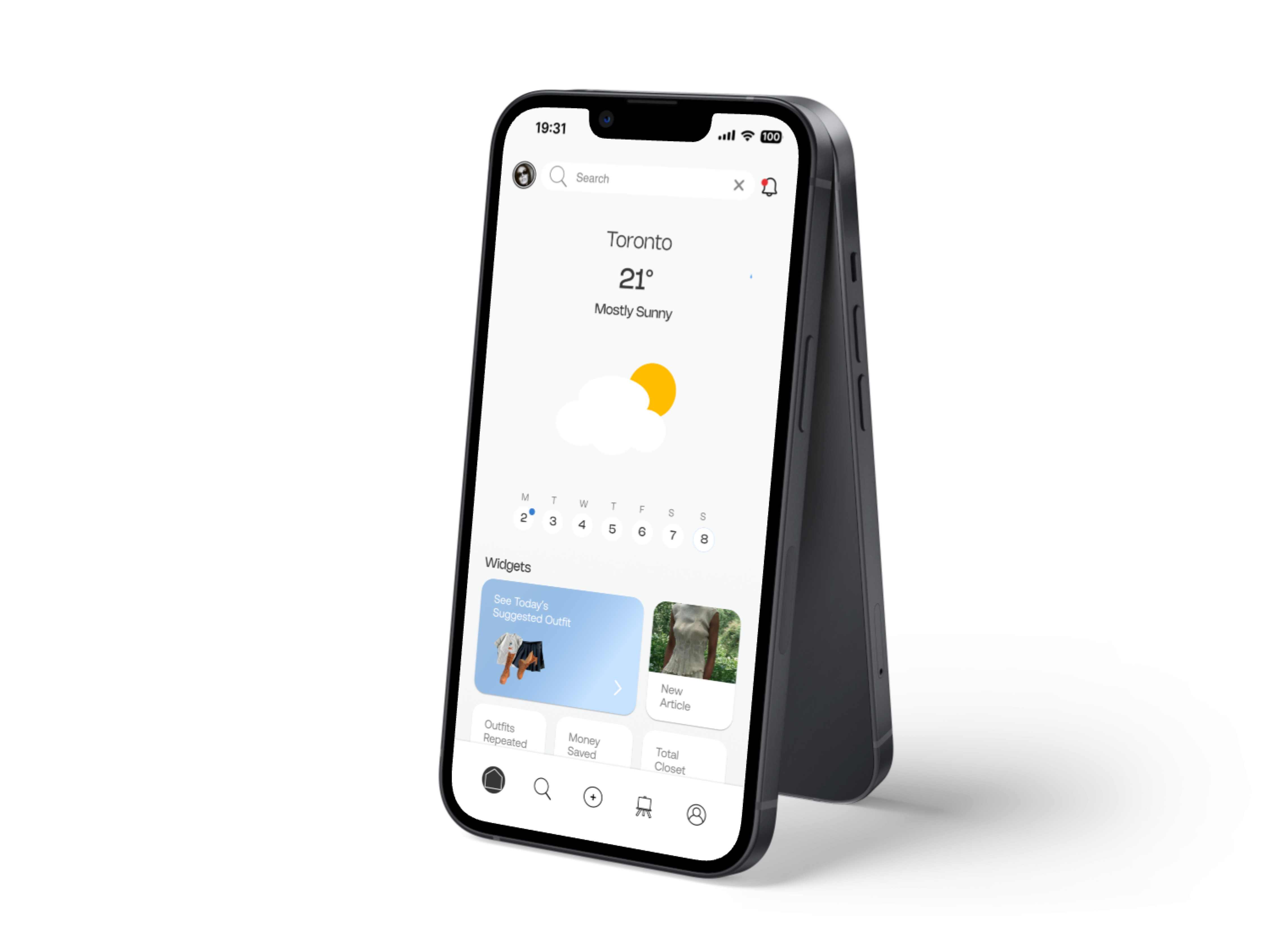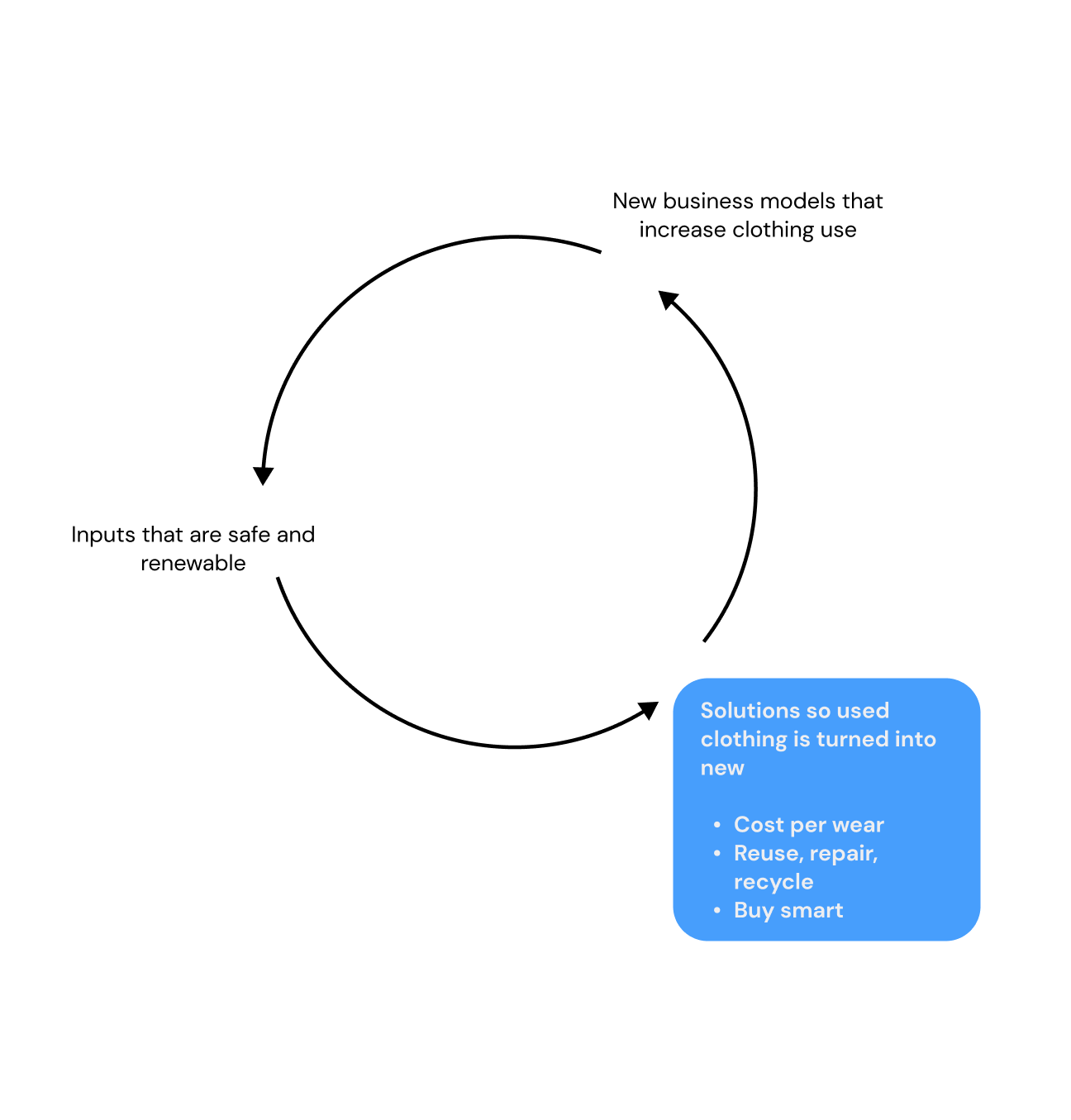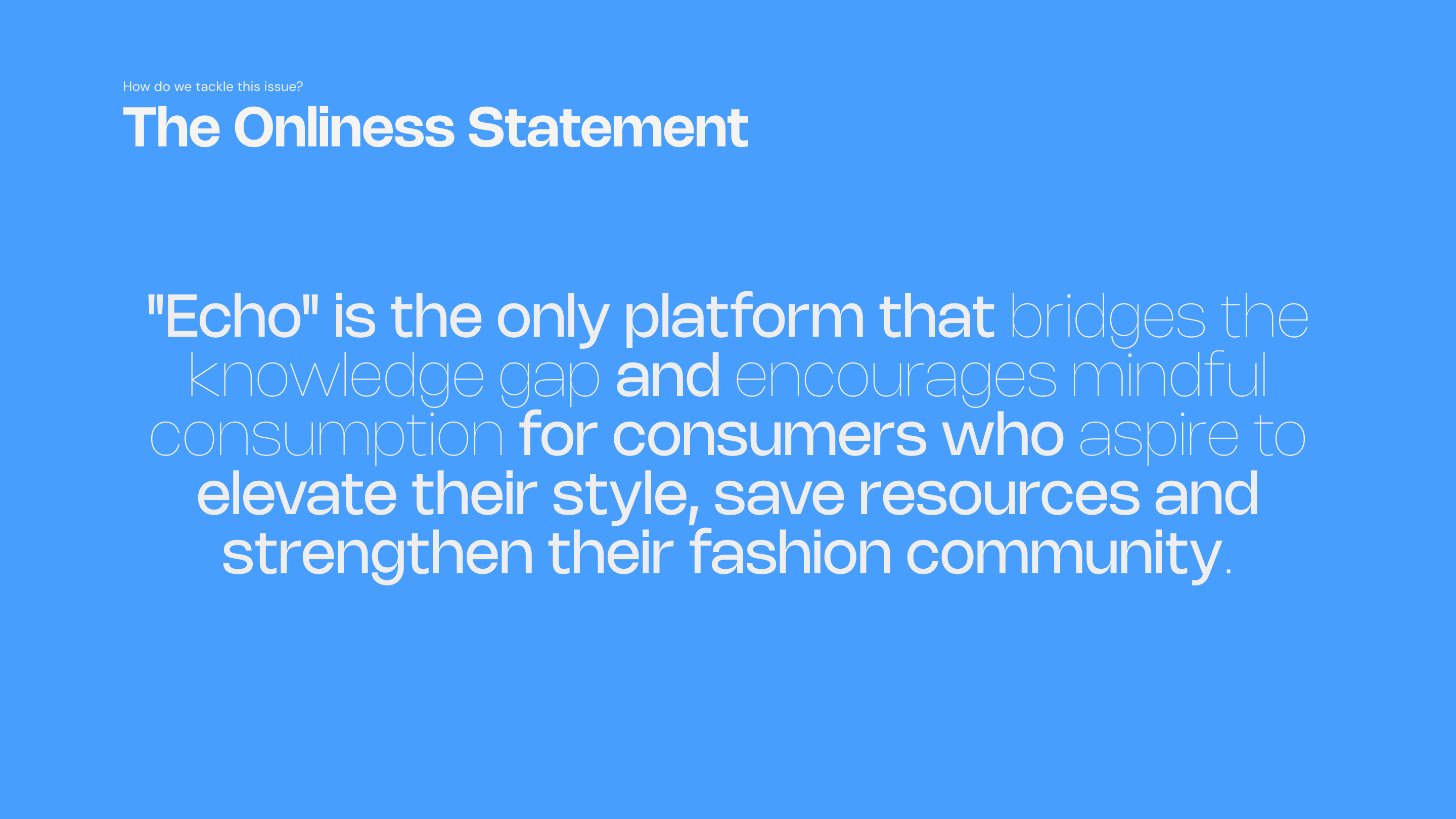Echo
Tackling Mass Fashion Consumerism with Circularity
[Master Thesis]

Abstract
Sustainability is a growing concern in fashion, where fast fashion and overconsumption contribute to a massive environmental footprint. Despite its ubiquity, clothing is vastly underutilized, especially in developed nations where artificial demand fuels premature disposal—costing consumers $460 billion annually (Eräpuu, 2023). Echo, an AI-powered fashion management app, aims to transform how users interact with their wardrobes. By enabling seamless clothing tracking and promoting mindful consumption, Echo encourages users to prioritize quality over quantity, fostering sustainable fashion habits and reducing waste.


Research
Desk + User Research
To better understand the topic and underlying causes, the inital research was organized into five main themes: intention vs. behavior, emergence of circularity, underutilized clothing, sustainability standards, and greenwashing + misinformation.
Upon the first look, I realized that tackling some of the bigger issues may require government intervention so I decided to focus on a more approachable topic, altering consumer behaviours.
Through deeper exploration, I uncovered the influence of social media on consumer purchasing habits with several statistics that indicated consumer desires to purchase sustainably alonside statistics that showed behaviours that swayed otherwise. I also uncovered a rising phenomenon identified as circularity which can be defined as:
“Whereas sustainability mainly looks after the first stage of a product’s linear existence, circularity cares for its entire life cycle — from design and manufacture, to use, to re-use, to closing the loop with recycling or biological disposal.”


Through my network, I interviewed a total of 6 people. I used the desk research to help validate some of my assumptions. The interviewees and their purpose are listed as follows:
- Sustainability Analyst: Broader perspective on current sustainability practices
- Frequent Shoppers (4): Insight and behaviours of everyday consumers
- Fashion Influencer: Insights into the impact of their recommendations
Out of the interviews conducted, all participants indicated their care for the environment but described several pain points such as price, influence and difficulty identifying quality items thus deterring them from purchasing more sustainably. It also seemed to be a shared sentiment that trend influence played a huge part in their purchasing patterns and that they lacked knowlege of circular fashion solutions.
Key Findings
From the research, three key insights and opportunities were developed which informed the problem definition.
Define
The Problem
Informed by these insights, I embarked on refining potential solutions, recognizing the imperative of instigating genuine behavioral change and prioritizing education. It became evident that any proposed solution should avoid the acquisition of new clothing. This realization guided the formulation of my "how might we" question and subsequently informed the creation of the onliness statement.
“How might we cultivate a circular economy, empowering consumers to embrace sustainable trends, prioritize quality, and enjoy a sense of style without missing out on the latest trends?
Ideation
During the ideation phase, the concept of creating a tracking app for closets, such as Echo, emerged as a promising solution. This idea stemmed from recognizing a gap in the market—users needed assistance in identifying materials, costs, and other relevant information about their clothing items. Understanding that users often seek convenience, it was imperative to design a solution that catered to their inherent laziness, making it effortless for them to engage with sustainable practices.
The Target
I developed a persona named Nina, a 22-year-old marketing professional from Toronto, ON, to illuminate the user journey and address key pain points. Nina embodies the ideal user—a fashion-forward individual seeking to document her style evolution while prioritizing quality and sustainability in her wardrobe choices. The app primarily targets women due to their heavy involvement in the fashion industry, yet remains inclusive of all genders, targeting individuals aged 18-29 frequently engaged on social media platforms. Leveraging insights from Nina's journey, I crafted features that resonate with user needs, informing the application's design and direction.
Ideate
Customer Journey
To better understand the main features of the application and visualize how a user (in this case, Nina) would utilize this in a realistic way, a user journey map was developed showcasing before, during and after phases of Echo usage.


From here, I created an architecture map to map out the application and understand how things would interact with eachother. This map delineates how different sections of the application can be strategically arranged and accessed. The main page layout is structured into distinct sections, aligning with the information architecture framework. These sections correspond closely with the key stages outlined in the user journey. The main navigation bar features:
Home Feed: This is a dashboard that includes summarized insights of your wardrobe, a calendar to plan and track outfits, detailed weather forecast and AI outfit suggestions.
Discover: Explore insights and information on circular fashion principles including information on how to care properly for clothing to promote longevity.
Posting: Log your outfits and items and assess their sustainability, tracking details like cost per wear, materials, and brands.
Inspo: Explore diverse styles, search for specific wardrobe pieces, and ignite your creativity with a daily dose of fashion inspiration within the Echo community.
Profile: Access an archive of past outfits and a comprehensive inventory with detailed stats such as cost per wear.
Outfit Canvas Creation: Using the application’s existing feature to log clothing items, users would be able to visualize and plan outfits on a canvas, enhancing the app’s utility for daily ensemble preparation. This allows users to effortlessly experiment with outfit combinations and organize them into personalized folders. This feature not only amplifies the utility of the app for planning daily ensembles but also enhances the creative process of fashion exploration.


Name + User Interface
“Echo” embodies the spirit of circularity, echoing the essence of repetition and continuity in fashion. The name signifies a commitment to sustainability by emphasizing the importance of reusing, reimagining, and prolonging the life cycle of clothing items.For a sustainable fashion app like “Echo” that focuses on circularity, eco-consciousness, and reusability, a colour scheme that embodies these principles were ideal when constructing the solution. Since the universal colour for recycling is blue, the colour palette includes calming blues and lots of white space to indicate simplicity.
Echo is designed to resonate with a modern and younger audience, particularly women, who are keen on fashion and therefore typically enjoy visual aesthetics. Its design draws inspiration from contemporary graphic styles that embody elegance, sophistication, and simplicity.

The style guide had to be reworked throughout the process of creating the application but the following makes up the final style guide.
Wireframing, Testing + Iteration
In the initial stages of development, I explored the possibility of incorporating a social media aspect into the app. My assumption was that users might not feel motivated to document their items unless the app offered additional value through social interactions. Consequently, these assumptions influenced the direction of our wireframes. However, during preliminary concept testing, we discovered that this approach resulted in an overly complex app for its initial version. It became evident that we needed to streamline the app to better align with its core purpose.
Through interviews and user feedback, we uncovered a genuine interest among users in tracking their clothing items and collaborating on outfit planning. Users expressed enthusiasm for the idea of creating preplanned outfits using the items they logged in the app. Additionally, they found the tracking feature to be particularly valuable in gaining insights into their closets. These insights prompted us to pivot towards a simplified approach focused on empowering users to curate their wardrobe and plan outfits efficiently.
Later versions of the application also included more complicated user experiences and were later refined in the final stages through user testing and iteration. For example, tagging screens included several navigation paths and were modified to all be included on one page as shown below.
Before:

After:

Outcome
Introducing Echo: Your sustainable fashion companion. Echo goes beyond conventional fashion apps by serving as your outfit diary, sustainability tracker, and community hub. With Echo, you can effortlessly document your style journey, prioritize quality and sustainability, and connect with like-minded individuals. Revolutionize your approach to fashion and embrace mindful consumption with Echo.



